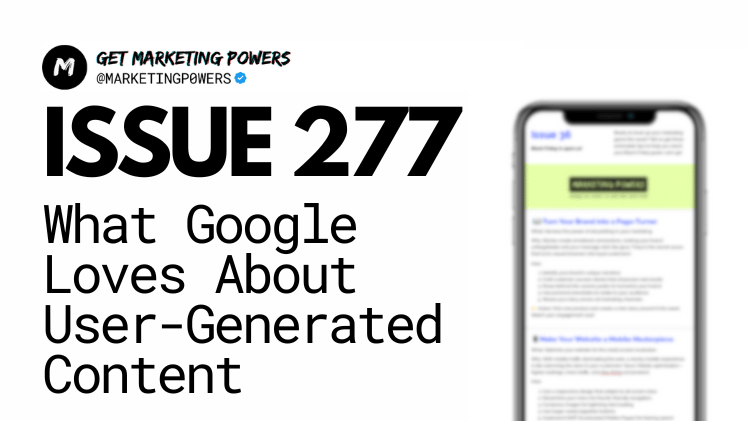- The Strategy of Marketing: Get Marketing Powers
- Posts
- Turn Testimonials, Reviews & Comments Into SEO Fuel - Issue 277
Turn Testimonials, Reviews & Comments Into SEO Fuel - Issue 277
How to Leverage User-Generated Content for SEO

Hey there,
You know content is critical for SEO. But here’s what most marketers overlook:
👉 Some of your best SEO content?
You don’t even have to write it.
We’re talking about user-generated content - reviews, testimonials, comments, case studies, social posts, and more. In 2025, UGC is no longer just social proof - it’s an SEO supercharger.
Google loves authentic, fresh, and experience-driven content.
That’s exactly what your users create for you.
This week, we’ll show you how to turn UGC into a scalable content asset that improves rankings, increases time on site, and builds trust at every stage of the funnel.

🚀 Growth Fix: Let Your Customers Do the (SEO) Work for You
The Problem:
You’re investing heavily in SEO but…
❌ It’s hard to keep up with content production
❌ Engagement is low
❌ Your content sounds… robotic
Why This Hurts Your Business:
Search engines (and users) crave authenticity. UGC brings natural language, varied perspectives, and real-life relevance that polished brand content often lacks. If you’re not leveraging it, you’re leaving organic growth on the table.
✅ The Fix:
Encourage and feature UGC across key website pages
Use structured data to help Google crawl and rank it
Turn UGC into blog posts, landing page testimonials, and product FAQs
An e-commerce brand started featuring verified buyer reviews (with long-form answers) directly on its product pages.
They added schema markup, embedded customer photos, and encouraged buyers to share use cases.
📈 The result?
+34% increase in organic impressions
+22% increase in rankings for long-tail “how to use” and “best for” queries
+18% lift in conversion rate on UGC-enhanced pages
Why it worked?
It wasn’t just product info - it was customer language, use cases, and real-world value.
⚡ 5 Wins for Using UGC to Boost SEO
1️⃣ Add Review Schema to Boost Search Appearance
💡 The Win: Show star ratings in search results = instant credibility and more clicks.
🛠️ Why It Works:
Google rewards rich results when you use structured data (schema). Reviews and ratings make your listings more eye-catching and trustworthy.
🎯 Action Tip:
→ Use Review Schema on product, service, or testimonial pages
→ Make sure reviews are crawlable (don’t hide them in iframes or JS)
→ Ask customers to include keywords in their reviews (“This CRM helped us streamline onboarding…”)
2️⃣ Create UGC Fuelled Content Pages
💡 The Win: Turn testimonials, comments, and social posts into new SEO content.
🛠️ Why It Works:
UGC helps build fresh, relevant, and keyword-rich content — especially long-tail phrases your audience actually uses.
🎯 Action Tip:
→ Turn common customer questions into FAQ pages
→ Compile “What Our Users Say About [Feature]” blog posts
→ Build use case pages from detailed case study quotes or feedback threads
3️⃣ Optimise UGC on Product/Service Pages
💡 The Win: Boost on-page SEO and reduce bounce rates.
🛠️ Why It Works:
When users land on a page and see relatable testimonials, images, or real-world use cases, they stay longer — which signals value to Google.
🎯 Action Tip:
→ Feature UGC near call-to-action buttons
→ Pull in customer quotes that address objections (“I was worried about setup, but…”)
→ Include customer-submitted media (photos, videos) where possible
4️⃣ Incentivise UGC with Smart CTAs
💡 The Win: Get more UGC, consistently.
🛠️ Why It Works:
Most users won’t create content without a prompt or reward. But a small incentive can lead to high-quality SEO fuel.
🎯 Action Tip:
→ Offer discounts, loyalty points, or social shoutouts for leaving detailed reviews
→ Create UGC campaigns (“Share how you use our product to win X”)
→ Ask open-ended questions post-purchase: “What problem did this solve for you?”
5️⃣ Use UGC to Power Your Internal Linking Strategy
💡 The Win: Turn UGC into an SEO signal boost across your site.
🛠️ Why It Works:
Internal links help spread SEO authority - and UGC can naturally link to related features, blog posts, or use cases.
🎯 Action Tip:
→ Within UGC blog posts, link to product features or case studies
→ In FAQs sourced from real users, point to support docs or video guides
→ Use UGC quotes to anchor internal links with descriptive, long-tail anchor text
Take Action This Week:
✅ Enable reviews or testimonials on high-traffic pages
✅ Pull real customer quotes into your product, landing, or feature pages
✅ Implement review schema markup to boost search visibility
✅ Compile customer feedback into blog posts or social threads
✅ Launch a small incentive to encourage UGC submissions
UGC isn’t just for social proof - it’s an SEO strategy.
And the best part? It scales with your customer base.
Let your users speak. Google (and your future customers) are listening.
Talk soon,